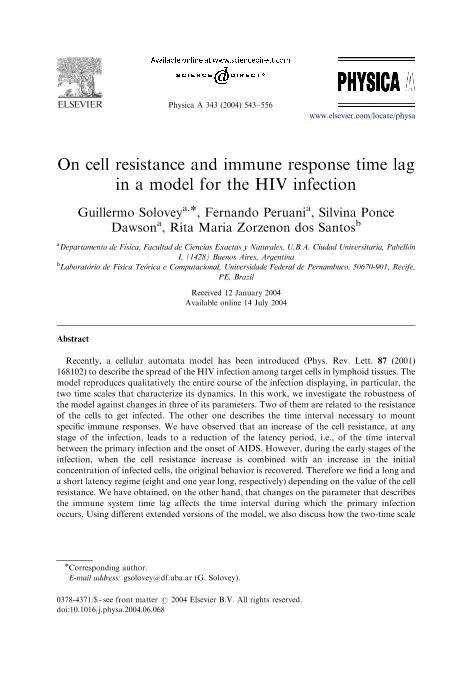Mostrar el registro sencillo del ítem
dc.contributor.author
Solovey, Guillermo

dc.contributor.author
Peruani San Román, Fernando Miguel

dc.contributor.author
Ponce Dawson, Silvina Martha

dc.contributor.author
Dos Santos, Rita Maria Zorzenon
dc.date.available
2019-04-08T16:17:50Z
dc.date.issued
2004-12
dc.identifier.citation
Solovey, Guillermo; Peruani San Román, Fernando Miguel; Ponce Dawson, Silvina Martha; Dos Santos, Rita Maria Zorzenon; On cell resistance and immune response time lag in a model for the HIV infection; Elsevier Science; Physica A: Statistical Mechanics and its Applications; 343; 1-4; 12-2004; 543-556
dc.identifier.issn
0378-4371
dc.identifier.uri
http://hdl.handle.net/11336/73395
dc.description.abstract
Recently, a cellular automata model has been introduced (Phys. Rev. Lett. 87 (2001) 168102) to describe the spread of the HIV infection among target cells in lymphoid tissues. The model reproduces qualitatively the entire course of the infection displaying, in particular, the two time scales that characterize its dynamics. In this work, we investigate the robustness of the model against changes in three of its parameters. Two of them are related to the resistance of the cells to get infected. The other one describes the time interval necessary to mount specific immune responses. We have observed that an increase of the cell resistance, at any stage of the infection, leads to a reduction of the latency period, i.e., of the time interval between the primary infection and the onset of AIDS. However, during the early stages of the infection, when the cell resistance increase is combined with an increase in the initial concentration of infected cells, the original behavior is recovered. Therefore we find a long and a short latency regime (eight and one year long, respectively) depending on the value of the cell resistance. We have obtained, on the other hand, that changes on the parameter that describes the immune system time lag affects the time interval during which the primary infection occurs. Using different extended versions of the model, we also discuss how the two-time scale dynamics is affected when we include inhomogeneities on the cells properties, as for instance, on the cell resistance or on the time interval to mount specific immune responses. © 2004 Elsevier B.V. All rights reserved.
dc.format
application/pdf
dc.language.iso
eng
dc.publisher
Elsevier Science

dc.rights
info:eu-repo/semantics/openAccess
dc.rights.uri
https://creativecommons.org/licenses/by-nc-sa/2.5/ar/
dc.subject
Cellular Automata
dc.subject
Dynamical Systems
dc.subject
Hiv Infection
dc.subject
Pattern Formation
dc.subject.classification
Astronomía

dc.subject.classification
Ciencias Físicas

dc.subject.classification
CIENCIAS NATURALES Y EXACTAS

dc.title
On cell resistance and immune response time lag in a model for the HIV infection
dc.type
info:eu-repo/semantics/article
dc.type
info:ar-repo/semantics/artículo
dc.type
info:eu-repo/semantics/publishedVersion
dc.date.updated
2019-04-05T18:39:59Z
dc.journal.volume
343
dc.journal.number
1-4
dc.journal.pagination
543-556
dc.journal.pais
Países Bajos

dc.journal.ciudad
Amsterdam
dc.description.fil
Fil: Solovey, Guillermo. Consejo Nacional de Investigaciones Científicas y Técnicas. Oficina de Coordinación Administrativa Ciudad Universitaria. Instituto de Física de Buenos Aires. Universidad de Buenos Aires. Facultad de Ciencias Exactas y Naturales. Instituto de Física de Buenos Aires; Argentina
dc.description.fil
Fil: Peruani San Román, Fernando Miguel. Facultad de Ciencias Exactas y Naturales; Argentina
dc.description.fil
Fil: Ponce Dawson, Silvina Martha. Consejo Nacional de Investigaciones Científicas y Técnicas. Oficina de Coordinación Administrativa Ciudad Universitaria. Instituto de Física de Buenos Aires. Universidad de Buenos Aires. Facultad de Ciencias Exactas y Naturales. Instituto de Física de Buenos Aires; Argentina
dc.description.fil
Fil: Dos Santos, Rita Maria Zorzenon. Universidade Federal de Pernambuco; Brasil
dc.journal.title
Physica A: Statistical Mechanics and its Applications

dc.relation.alternativeid
info:eu-repo/semantics/altIdentifier/doi/http://dx.doi.org/10.1016/j.physa.2004.06.068
Archivos asociados
